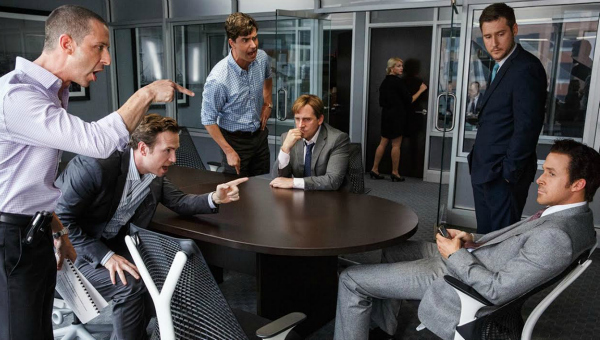THE BIG SHORT, adapted from the exposé of the same name, tells the story of the 2008 US financial crash from the point of view of several characters – all of them to some extent involved in trading either on or off Wall Street.
Michael Burry (played with mad-eyed intensity by Christian Bale) is an outsider, a genius hedge-fund manager whose attention to detail helps him to spot the rotten core of the housing market before others do. His actions, laying financial bets against the housing market collapse, draw the attention of others to the possible financial gain.
One such character is Ryan Gosling’s Jared Vennett, an insider at Deutsche Bank, who acts as the film’s knowing narrator. Where Bale’s character is shown always in isolation – an office, shutters part-shut, or in his basement garage – Gosling is the chancer who draws others into the trade.
Perhaps the most complex character is Mark Baum (Steve Carell). His first entrance is at a therapy group, which he rudely interrupts. A combination of grief and anger propels him to crusade against the lies and arrogance at the heart of Wall Street. His fund is backed by Morgan Stanley – the fund uses their offices – but tellingly, apart from it. It’s a testament to Steve Carell that he keeps the audience on side, despite Baum’s negative traits. Carell has played serious before, most notably in LITTLE MISS SUNSHINE and FOXCATCHER, but here he excels, subtly showing the character’s substance.
The filming style is a mix of standard character drama – the individual stories play out at an even pace, in chronological order – and faux-documentary, with choppy cuts and camera swings. To show the passage of time, fast pictorial montages of current events play in between scenes. It’s a trick that doesn’t always work – the characters and drama are enough to keep the audience interested – and it’s a filming style that’s already been over-done on TV drama following on from THE WIRE.
“You know what I hate about fucking banking? It reduces people to numbers.”
One neat trick that does work is the way of showing financial jargon and potentially difficult concepts through interludes where celebrities explain these terms. The most successful of these interludes, and the most obviously satirical, is set in a Las Vegas casino, at the heart of America’s gambling community (or is that Wall Street?) A seasoned academic, and pop star Selena Gomez, show how the security-backed trades – or bets – stack up to become intrinsically, and dangerously, worthless. Gomez is the distraction: the flashy pop star trumps the academic, who is telling the audience what they really need to know.
One aspect that the film never really touches on is the dubious morality at the heart of the ‘big short’. All of the characters are part of the financial system, albeit most of them outsiders. We’re shown that they are laughed at and ridiculed by the banks and their peers for betting against the market, but we’re not shown anything but the financial outcome of their eventual gains. As ex-trader Ben Rickert (Brad Pitt) warns his protégés, who are jubilant at the thought of making more money: ‘If we’re right, people lose homes. People lose jobs. People lose retirement savings, people lose pensions. You know what I hate about fucking banking? It reduces people to numbers.’
Director Adam McKay might at first seem a strange choice to direct the film, given his pedigree as a comedy director with films such as ANCHORMAN. However, McKay directing brings a lightness of touch and some much needed comedy to leaven the drama, particularly in terms of Gosling’s narration. It’s interesting to note that this was clearly a passion project for McKay – he co-wrote the screenplay – and that the studio would only back him for the financially riskier THE BIG SHORT if he also made the safer bet in ANCHORMAN 2; heavily ironic given the subject matter of this film. It’s a shame, as the documentary THE CORPORATION and the play ENRON had already taken the same subject of the US financial collapse and given it a twist, much earlier.
At the end of the film, Gosling’s narrator speaks to the audience about how little has changed in terms of the market and financial regulation, a reminder that another collapse could be a very likely possibility. It’s a point that’s made earlier in the film, where in a nearly-abandoned new housing development in Florida, a crocodile surfaces from the complex’s pool: symbolic of the underlying danger that’s just beneath the reflective surface.
httpvh://youtu.be/rDlYm15ztK4

